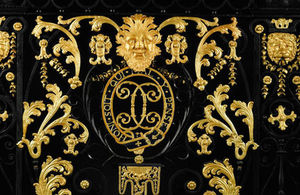Rare Chesterfield House railings at risk of leaving the UK
Culture Minister steps in to prevent ornate railings from export

Ornate 18th century ironwork railings from Chesterfield House
A set of ornate 18th century ironwork railings is at risk of being exported from the UK unless a buyer can be found to match the asking price of £305,000.
Culture Minister Matt Hancock has placed a temporary export bar on the railings that once surrounded the residence of the 4th Earl of Chesterfield to provide an opportunity to keep them in the country.
Made of wrought and cast iron with gilt iron and gilt bronze embellishments, they are among the most highly decorated examples in Britain, and illustrate how ornate ironwork was used to show social status in the 18th century.
Built in the 1740s, Chesterfield House was one of the grandest and most famous addresses in London and the railings were intended to impress guests and be viewed from the ground floor reception rooms.
The demolition of this great London mansion in 1937 was the catalyst for the foundation of The Georgian Group, which celebrates its 80th anniversary in 2017.
Minister of State for Digital and Culture Matt Hancock said:
More than 80 years after Chesterfield House was sadly torn down, these lavishly decorated railings are a reminder of the opulence of the 18th century London elite and the wonderful craftsmanship of the time.
I hope that a buyer comes forward to help keep them in the UK so that we may enjoy their beauty and learn more about the fascinating ironwork techniques used at the time.
The set of railings is believed to have been supplied by Jean Montigny, a French Catholic immigrant who specialised in wrought iron, for the 1st Duke of Chandos’s remarkable house, Cannons, in Edgware, in the 1720s. They were then acquired for Chesterfield House, London, for which they were modified in the late 1740s.
The decision to defer the export licence follows a recommendation by the Reviewing Committee on the Export of Works of Art and Objects of Cultural Interest (RCEWA), administered by The Arts Council.
RCEWA member Philippa Glanville said:
Admired for more than 250 years for their design and craftsmanship, this set of railings vividly demonstrates how noblemen adorned the exteriors of their London palaces as richly as their interiors. These are rare survivors and exemplify the peak of wrought ironwork, one of the glories of eighteenth century patronage in Britain.
The RCEWA made its recommendation on the grounds of the railings’ outstanding aesthetic importance and their significance for the study of British patronage of the highest quality ironwork, as well as of metalwork design, decorative techniques and subsequent structural and decorative modifications.
The decision on the export licence application for the railings will be deferred until 3 July 2017. This may be extended until 3 October 2017 if a serious intention to raise funds to purchase them is made at the recommended price of £305,000 (plus VAT of £61,000).
Organisations or individuals interested in purchasing the railings should contact the RCEWA on 0845 300 6200.
Images of the railings can be downloaded from our flickr site.
ENDS
For media information contact:
Yasmin Kaye Communications Officer Department for Culture Media and Sport Tel: 0207 211 6489 Email: yasmin.kaye@culture.gov.uk
Notes to editors
-
Details of the railings are as follows: Two sets of railings, each of three sections, made of wrought and cast iron, painted black, with gilt iron and gilt bronze decoration. Each set comprises a central section with interlaced Cs encircled by the Garter Ribband suspended from a bearded gilt bronze mask, flanked by acanthus scrolls and floral swags; and two flanking sections of railing with gilt rosettes at mid-height between spiked-topped upright rods, and framed at each end by more ornate upright sections with gilt urns at the highest points above gilt bronze lion masks beneath. Each section = 236cm high, 230cm wide and 45cm deep, including supporting plinths.
-
Details of provenance are available at the Sotheby’s catalogue.
-
The Reviewing Committee on the Export of Works of Art and Objects of Cultural Interest is an independent body, serviced by The Arts Council, which advises the Secretary of State for Culture, Media and Sport on whether a cultural object, intended for export, is of national importance under specified criteria.
-
The Arts Council champions, develops and invests in artistic and cultural experiences that enrich people’s lives. It supports a range of activities across the arts, museums and libraries – from theatre to digital art, reading to dance, music to literature, and crafts to collections. www.artscouncil.org.uk.